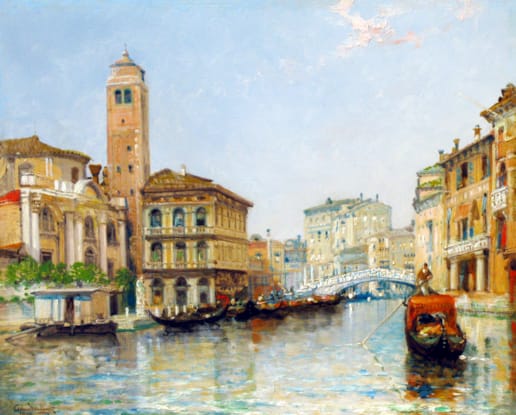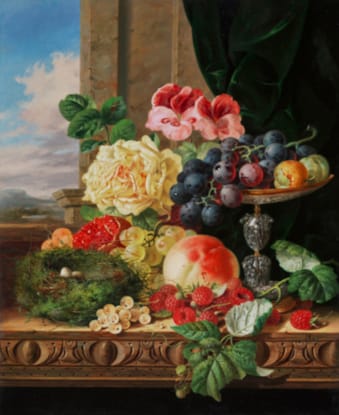George Vicat Cole, RA
(1833 - 1893)
Wargrave
Signed with monogram and dated, lower left: 18VC81
Oil on canvas
35 x 56¼ in – 89 x 142.9 cm
Frame size
42½ x 63¼ in – 108 x 160.6 cm
Oil on canvas
35 x 56¼ in – 89 x 142.9 cm
Frame size
42½ x 63¼ in – 108 x 160.6 cm
Tel.: +44 (0)20 7839 7693
Provenance
John Hargreaves Esq. His sale, Christie’s, London, 2 May 1896, lot 39;
The Ralli Collection, Pamplin Manor, Wimborne, Dorset;
Sale Christie’s, London, 25 October 1991, lot 7;
Private collection, UK
The Ralli Collection, Pamplin Manor, Wimborne, Dorset;
Sale Christie’s, London, 25 October 1991, lot 7;
Private collection, UK
Art Journal, 1881, p.188;
Henry Blackburn, Academy Notes, 1881, p.27;
Robert Chignell, The Life and Paintings of Vicat Cole, RA, 1898, III, pp.75-79
Henry Blackburn, Academy Notes, 1881, p.27;
Robert Chignell, The Life and Paintings of Vicat Cole, RA, 1898, III, pp.75-79
London, Royal Academy, 1881, no.203
Biography
George Vicat Cole was born on 17th April 1833, the son of the distinguished landscape painter George Cole (1810-1883). He was brought up in the studio of his father and accompanied George Cole on sketching tours to the Wye Valley, the Dart in Devon and in 1851 to the Moselle. In an auspicious start to his career, he first exhibited at the British Institution in 1852, a landscape which sold for £21.
The same year, the family moved to London and George Vicat Cole exhibited at the Society of British Artists and the following year at the Royal Academy. In 1855 he moved to Camden Town following a dispute with his father, and married the following year. His landscapes of the period were much influenced by the Pre-Raphaelite methods and techniques and by the exhortation of Ruskin to be true to nature. Cole painted in Surrey and Hampshire, in 1857-1859 near Guildford, where in 1858, he met Benjamin Williams Leader (1831-1923) and formed a lasting friendship. Cole’s landscapes, painted in the early 1860’s from a mobile hut, portrayed precisely the landscape before him in every detail. He was becoming highly successful, collectors of his work being largely involved in commerce and industry, town dwellers who desired an idealised view of the English landscape, harvest time, or a view of the Arun and its water meadows.
In 1863 Cole resigned from the society of British Artists after five years in order to seek membership at the Royal Academy, to which he was elected ARA in 1870, the first pure landscape painter for 20 years. In 1868, Cole had moved to Kensington and in 1874 to Little Campden House in Kensington, an indication of his success and affluence. In 1877 his RA exhibit “Arundel” was highly praised and purchased by the Art Gallery of New South Wales and in 1879, now in what was to be the high point of an illustrious career, William Agnew commissioned the Thames series, initially six, expanded to twenty five, views of the River Thames from its source to the sea. Cole was to devote his remaining years to the much acclaimed Thames series which proved commercially highly successful; the “Pool of London” of 1887 was purchased by the Charity Bequest for £2,000, a previously unheard of figure.
The series cemented his reputation as one of the finest English landscape painters of the nineteenth century in the great tradition of Richard Wilson (1713-1782), John Constable (1776-1837) and J. M. W. Turner (1775-1851).
The same year, the family moved to London and George Vicat Cole exhibited at the Society of British Artists and the following year at the Royal Academy. In 1855 he moved to Camden Town following a dispute with his father, and married the following year. His landscapes of the period were much influenced by the Pre-Raphaelite methods and techniques and by the exhortation of Ruskin to be true to nature. Cole painted in Surrey and Hampshire, in 1857-1859 near Guildford, where in 1858, he met Benjamin Williams Leader (1831-1923) and formed a lasting friendship. Cole’s landscapes, painted in the early 1860’s from a mobile hut, portrayed precisely the landscape before him in every detail. He was becoming highly successful, collectors of his work being largely involved in commerce and industry, town dwellers who desired an idealised view of the English landscape, harvest time, or a view of the Arun and its water meadows.
In 1863 Cole resigned from the society of British Artists after five years in order to seek membership at the Royal Academy, to which he was elected ARA in 1870, the first pure landscape painter for 20 years. In 1868, Cole had moved to Kensington and in 1874 to Little Campden House in Kensington, an indication of his success and affluence. In 1877 his RA exhibit “Arundel” was highly praised and purchased by the Art Gallery of New South Wales and in 1879, now in what was to be the high point of an illustrious career, William Agnew commissioned the Thames series, initially six, expanded to twenty five, views of the River Thames from its source to the sea. Cole was to devote his remaining years to the much acclaimed Thames series which proved commercially highly successful; the “Pool of London” of 1887 was purchased by the Charity Bequest for £2,000, a previously unheard of figure.
The series cemented his reputation as one of the finest English landscape painters of the nineteenth century in the great tradition of Richard Wilson (1713-1782), John Constable (1776-1837) and J. M. W. Turner (1775-1851).




_1142024T14270.140.jpg?width=550&height=415&format=jpg&quality=80&mode=max)